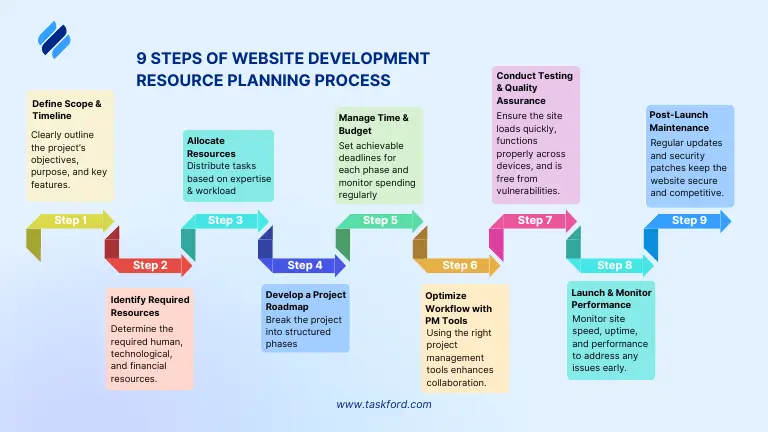Website Development Planning Process — Step-by-Step Guide 2025
Learn how to plan and allocate resources effectively for a successful website project.
Planning a website is more than just coding and design—it requires careful resource management to ensure smooth development, cost-effectiveness, and timely delivery. The web development resource planning process plays a crucial role in defining how effectively a project is executed.
With the increasing complexity of modern websites, companies need structured planning to allocate resources efficiently. This guide explores the complete process of web development resource planning in 2025, covering everything from team allocation to budget management and workflow optimization.
Website Development Resource Planning Process
1. What Is Resource Planning in Web Development?

Resource planning refers to the process of identifying, allocating, and managing the necessary resources—such as time, budget, personnel, and tools—to complete a web development project successfully. Effective resource planning ensures that every development aspect runs smoothly, avoiding delays and budget overruns.
2. Key Elements of Resource Planning
- Resource Identification: Determining the types and quantities of resources needed, such as human, financial, physical, and time resources.
- Resource Allocation: Assigning resources to tasks or projects based on priority, availability, and skill matching.
- Scheduling: Planning the timing and duration of resource use for efficiency and coordination.
- Monitoring and Control: Tracking resource usage and adjusting as needed to meet goals.
- Risk Management: Identifying and mitigating potential resource-related risks, like shortages or conflicts.
- Tools and Techniques: Using software and methods to enhance planning and accuracy.

These steps ensure resources are managed effectively to achieve project or operational objectives.
3. Why Is Resource Planning Important?
- Prevents Resource Wastage: Avoids overuse or underuse of personnel and tools.
- Ensures Timely Delivery: Keeps projects on schedule by optimizing workflows.
- Improves Budget Control: Helps avoid unnecessary expenses.
- Enhances Collaboration: Promotes seamless teamwork and productivity.
- Reduces Risks: Minimizes errors, delays, and unexpected challenges.
Proper planning saves time, money, and frustration, setting the stage for a successful website launch.
Step-by-Step Website Development Resource Planning Process
Planning resources effectively is key to ensuring a website development project runs smoothly, stays within budget, and meets its deadlines. Below is a detailed, step-by-step process to guide you through resource planning for website development in 2025.

Step 1: Understand Project Scope & Timeline
Before allocating resources, clearly outline what the project entails and what you aim to achieve.
-
Identify the purpose of the website: Different types of websites require different levels of planning and resources. Identifying the purpose of the website helps determine the necessary features and technical requirements.
Example: Building a corporate website that focuses on brand awareness and lead generation, requiring strong SEO, a blog, and a contact form.
-
Set clear business goals: Once the purpose is defined, establish measurable goals using the SMART framework (Specific, Measurable, Achievable, Relevant, and Time-bound).
Example: Increasing organic traffic by 40% in six months through strategic content creation and SEO optimization.
-
Determine key features and functionalities: After setting goals, create a list of must-have features based on business needs. This helps prioritize essential functions while avoiding unnecessary costs.
Example: Core features - content management, user authentication, SEO tools.
-
Establish a realistic timeline: Define project milestones and deadlines to keep development on track.
Example: Plan for wireframing (2 weeks), development (4 weeks), and testing (3 weeks) to keep the project on track.
A well-structured project scope ensures the website aligns with business objectives while maintaining efficiency in resource allocation.
Step 2: Identify Required Resources
After defining the scope and timeline, the next step is identifying the resources needed for the project. Resources fall into three major categories: human resources (developers, designers, content creators), technology resources (design tools, coding framework, hosting platforms) and budget planning (estimate costs for tools and any third-party services)
- Tips: Utilize the Resource Breakdown Structure RBS to categorize resources into human, technology, and financial segments.
- Example: A team might include a UX designer, two front-end developers, a back-end developer, and a content strategist.
Step 3: Allocate Resources
With the resources identified, the next step is proper allocation to ensure that everything progresses smoothly. The development team should be assigned tasks based on their expertise, and critical phases such as wireframing and core functionality development should be prioritized.
Project managers should allocate time and effort efficiently to avoid resource overload. Using resource management tools such as Trello, Jira, or Monday.com helps in tracking workloads and deadlines. A well-planned resource allocation strategy helps prevent bottlenecks and ensures that all tasks are completed within the stipulated timeframe.
Step 4: Develop a Project Roadmap
A website development roadmap provides a structured approach to executing the project. It divides the project into key phases, ensuring that all necessary tasks are completed in the right order.
Example:
Planning & Research → Wireframing & Design → Development → Content Creation & SEO → Testing & Debugging → Launch & Monitoring.
Step 5: Manage Time & Budget Constraints
One of the biggest challenges in web development is managing time and budget constraints. Projects often experience delays due to poor time management, leading to increased costs.
Setting realistic deadlines for each phase ensures that the project stays on track. It is essential to estimate how long each task will take based on available resources and team capacity.
Tip: The Eisenhower Matrix (Urgent-Important Matrix) helps manage time and budget constraints by prioritizing tasks based on urgency and importance.
Step 6: Optimize Workflow with Project Management Tools
Using the right project management tools enhances collaboration and efficiency. There are various tools available for different aspects of website development, such as Jira and TaskFord for task management, Slack and Microsoft Teams for communication, and Figma or Adobe XD for design collaboration.
Implementing workflow automation wherever possible helps save time and reduce errors. Automated notifications for task deadlines, Kanban boards for visualizing progress, and centralized documentation ensure that the team stays aligned and productive.
Step 7: Conduct Testing & Quality Assurance
Before launching the website, extensive testing must be conducted to identify and fix errors. Testing includes functionality testing, performance testing, security testing, and compatibility testing.
Tip:** Using tools such as Google Lighthouse, Selenium, and BrowserStack, or AgileTest helps automate the testing process, making it more efficient.
Step 8: Launch & Monitor the Website
Once the website passes testing, it is ready for launch. Deployment should be done on a secure hosting platform that offers reliable uptime and fast performance. Before launching, it is important to set up analytics tools such as Google Analytics and Google Search Console to track user behavior and site performance.
The initial launch phase should be closely monitored to identify any technical issues that may arise. The development team should be prepared to address bugs or performance issues immediately. Having a rollback plan in place ensures that any major problems can be resolved quickly.
Step 9: Post-Launch Maintenance & Resource Planning
Website development does not end at launch. Continuous maintenance is required to ensure security, performance, and content relevance. Regular updates to plugins, frameworks, and security patches keep the website secure.
Monitoring website analytics helps identify areas that need improvement. If certain pages have high bounce rates or slow load times, they should be optimized accordingly. Businesses should also plan for scalability, ensuring that the website can handle increased traffic and additional features in the future.
Quarterly resource planning sessions help align web development goals with business growth. This ensures that the website remains an effective tool for achieving business objectives.
Final Thoughts
Effective resource planning is the backbone of successful website development. By following this structured process—from defining the scope to post-launch maintenance—you can deliver a website on time, within budget, and to the highest standards. In 2025, with technology evolving rapidly, staying organized and adaptable is more critical than ever. Apply these steps to your next project to streamline planning, avoid pitfalls, and exceed expectations.
FAQs for Website Development Planning Process
1. What is the most important step in resource planning for web development?
Understanding the project scope and timeline is critical. Without clear goals and deadlines, resource allocation becomes inefficient, leading to delays and cost overruns.
2. What is the best way to manage web development costs?
Break down the expenses into design, development, tools, and hosting. Use budget-tracking software to monitor costs.
3. How can I speed up web development without compromising quality?
- Use agile development methods.
- Automate testing & deployment. Assign tasks based on team expertise.
4. What tools are best for managing a web development project?
Jira or TaskFord for tasks, Slack for communication, and Figma for design collaboration are top choices. Pick tools that suit your team’s needs.
5. How often should a website be updated post-launch?
Regular updates should be made monthly for security, while major updates should occur quarterly to improve performance and user experience.
Making work simpler,
smarter, and more connected
Join our waitlist and be notified first.

Related Blog
Subscribe for Expert Tips
Unlock expert insights and stay ahead with TaskFord. Sign up now to receive valuable tips, strategies, and updates directly in your inbox.






